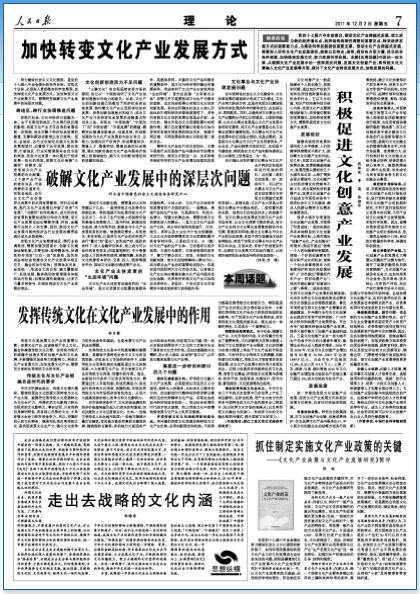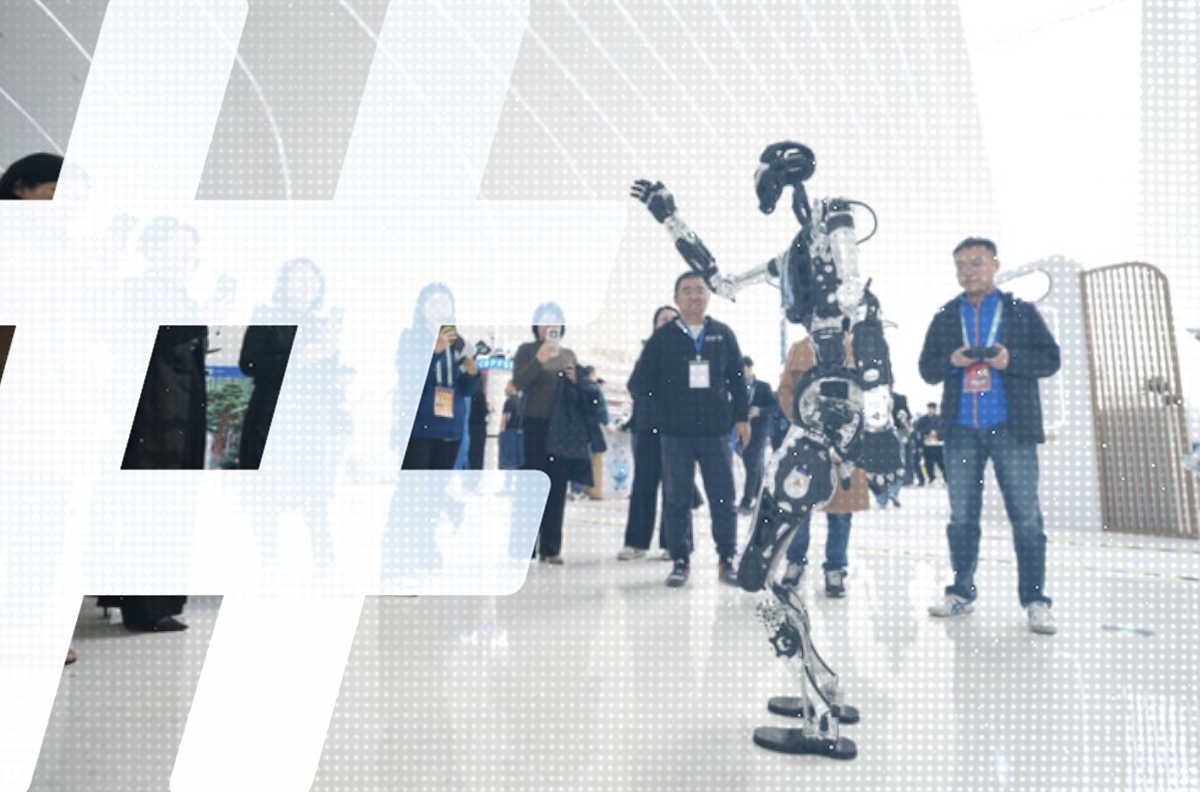Unpacking China’s latest policies on cultural reform, which emerged from October’s sixth plenum of the 17th Central Committee of the CCP, will be a process of many months. The October “Notice” on cultural reform is not so much a coherent program of cultural development as a mess of politics, ideology and commercial interests. And the Party’s own attempts to explain what these changes mean lead only to more befuddlement.
Take, for example, today’s edition of the Party’s official People’s Daily. While articles on cultural reform are scattered throughout the paper, page seven offers a series of pieces with the stated goal of “exploring methods of transition and development for the cultural industries.”

The first piece in the series, “Breaking Through Deep Issues in the Development of Culture Industries,” comes from the Hebei Province Research Center for the Theoretical System of Socialism with Chinese Characteristics. Here is the center’s introduction:
In a modern society, culture and the economy grow together into one with each passing day. Owing to various regional, industry and administrative lines, our country’s cultural industries have not only suffered the limitation of their own development, but the support of and drive for economic and social development in a larger sense has not been fully brought into play [as a result]. Therefore, various regions and industries should, in the forming and implementation of cultural reform and development planning, set their eyes on cooperative development, united development, breaking through . . . [the situation] of the backwardness of cultural development relative to the economic development.
Readers hoping for specifics are rewarded instead with more generalities. The article says that achieving cross-regional and cross-industry cultural industry development requires “the strengthening of top-level design, innovating the systems and mechanisms for cultural construction.”
The objectives broadly defined in this article seem valid enough. China must move toward greater innovation. Indeed. China must transition from a “made in China” model to a “created in China” model. Sure.
While there are many reasons for the emergence of “shanzai culture” [in China], on one level it can illustrate the loss of impetus for innovation and creation in the cultural industries. At the moment, our culture industries lag behind the overall economy and society in terms of innovation and creativity, and this has restrained the development of the culture industries as well as economic and social development. Fostering the impulse for creativity and innovation has become . . . a strategic focus and urgent task in the cultural and also social and economic development. Realizing the leap from “made in China” and “assembled in China” to “created in China” and “brand China” requires a salient emphasis on innovation consciousness (创新意识) and creative thinking (创造思维), making innovation and creativity the leading and driving forces of cultural industry development. [This means] strengthening the protection of intellectual property and creating a social environment that respects knowledge, respects talent, respect work and respects innovation. [This means] strengthening the position of creativity and innovation in the cultural service value chain, raising the quality and effectiveness of acts of innovation and creativity.
But how do you drive home a “salient emphasis on innovation consciousness and creative thinking” and nurture “the impulse for creativity and innovation” without relaxing the political and ideological environment in which people create in the first place? This, as I’ve stressed before, is the fundamental blind-spot of China’s cultural reforms.
How do you create “a social environment that respects knowledge” and innovation when the fundamental law on culture is the Party’s, the demand that culture “follow the correct political orientation” as spelled out in the October “Decision” on cultural reforms?
The paragraph above also talks about the “quality and effectiveness” of innovation and creativity. But what are the metrics for quality and effectiveness? Who decides what is quality and what is effective? Who gets to allocate resources on that basis?
The second article in the series begins with an assessment of the need for more cultural production on the basis of broader trends in economic growth:
In step with our country’s economic development and rising household incomes, the spiritual [or “non-material” = “cultural”] consumer demand of the people has steadily expanded, and this has promoted the emergence of cultural and creative industries. In the past few years, the cultural and creative industries in our country have developed rapidly, and the scope of development has expanded from several large cities like Beijing and Shanghai to principal cities throughout the country.
How will China now meet this rising demand? The article states confidently that “many major cities have placed great priority on cultural innovation and industry development, and have gained clear results.”
The city of Shanghai has raised the concept of ‘innovation industrialized and industry innovated’; the city of Nanjing has raised [the idea of] ‘making it such that every person’s creativity is encouraged, that every good creation has the opportunity to be marketed (市场化) and industrialized (产业化), and that every creator receives effective institutional support and favorable policy support’; the city of Guangzhou has raised [the concept of] ‘grabbing hold of the animation industry just [as it has] the automotive industry’; the city of Shenzhen has talked about building ‘the capital of innovative design; etcetera.
So the Party everywhere is talking about innovation. That’s no surprise, of course. They have little choice given that innovation has become the preeminent Party buzzword. And what about action? The article goes on to mention other specific measures, such as a pilot project offering tax reductions for cultural enterprises in Beijing, investment in the building of “cultural industry accumulation areas” (产业聚集区) — culture industry parks, that is — and working with banks to encourage loans to “cultural innovation enterprises” (文化创意企业).
I may seem to some to be belaboring this point, but there is an ongoing tension here between the “material” of hoped-for culture and the “spirit” of innovation. “Cultural industry accumulation areas” and loans for “cultural innovation enterprises” are all well and good. But the assumption seems to be that people will be innovating simply because these loans and parks exist. And there is that nagging question about the “social environment” for innovation alluded to in the first article in the People’s Daily series. Can you talk about innovation without talking about freedom? Whether you can or not, China is doing just that.
Nor can the discussion of cultural development escape the ideological conditioned response of defining Chinese cultural creation in opposition to the West — and thereby unnecessarily restricting its meaning and twisting its purpose. Who is going to decide whether innovations are sufficiently “Chinese”?
A third article on page 7 of the People’s Daily urges that policy making on cultural development take into account the uniqueness of the Chinese condition:
The writer believes that every country’s cultural industries have their own soil on which they live and their own conditions that give them full scope. Departing from definite historical conditions and social environments, the development modes of cultural industries must change. Therefore, in setting down policies for the cultural industries, while the advanced experiences of developed Western nations should be adopted, we cannot apply or mechanically copy development modes . . .
So innovation is great, but China has to make sure that whatever innovation it gets is Chinese enough.
This prerogative of “Chineseness” leads us to another of the bewildering contradictions in this push for cultural reform. As I said at the outset, this policy is a mess. So perhaps it shouldn’t surprise us that the top-down push to create innovative culture that is quintessentially Chinese also maintains as its “guiding principle” the political tenets of a 19th century German philosopher.
An article in the People’s Daily series addressing the “need to thoroughly leverage the capacity of [China’s] excellent traditional culture” offers the following proviso for cultural industry development:
“[We must] adhere to the correct development direction. In bringing traditional culture into [overall] cultural industry development, we must adhere to Marxism as the guiding principle, keeping to the tenets of serving the people and serving socialism . . . ”





















